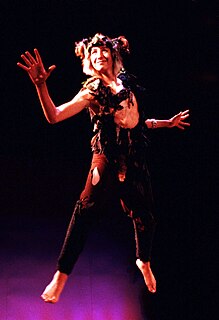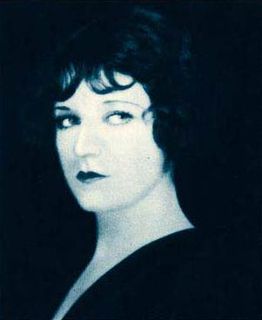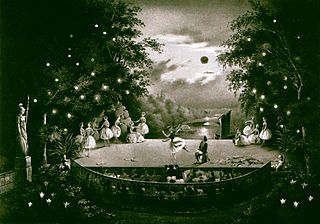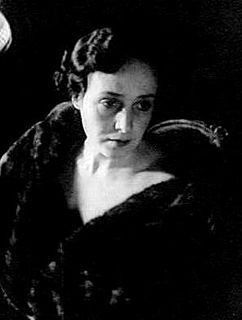
Puck, also known as Robin Goodfellow, is a character in William Shakespeare's play A Midsummer Night's Dream, based on the ancient figure of Puck found in English mythology.
Lúthien Tinúviel ['lu:θiɛ̯n ti'nu:viɛ̯l] Y.T. 1200–Y.S. 503; died aged 3377) is a fictional character in the fantasy-world Middle-earth of the English author J. R. R. Tolkien. She is an elf, daughter of Thingol and Melian. She appears in The Silmarillion, the epic poem The Lay of Leithian, the Grey Annals section of The War of the Jewels, and in other texts in Tolkien's legendarium. Her story is told to Frodo by Aragorn in The Lord of the Rings.

Melusine or Melusina is a figure of European folklore and mythology, a female spirit of fresh water in a sacred spring or river. She is usually depicted as a woman who is a serpent or fish from the waist down. She is also sometimes illustrated with wings, two tails, or both. Her legends are especially connected with the northern and western areas of France, Luxembourg, and the Low Countries. The House of Luxembourg, the Counts of Anjou and their descendants the House of Plantagenet and the French House of Lusignan are said in folk tales and medieval literature to be descended from Melusine.

Undine is a fairy-tale novella (Erzählung) by Friedrich de la Motte Fouqué in which Undine, a water spirit, marries a knight named Huldebrand in order to gain a soul. It is an early German romance, which has been translated into English and other languages.

Princess and dragon is a generic premise common to many legends, fairy tales, and chivalric romances. Northrop Frye identified it as a central form of the quest romance.

Viola Dana was an American film actress who was successful during the era of silent films. She appeared in over 100 films, but was unable to make the transition to sound films.

Undines are a category of imaginary elemental beings associated with water, first named in the alchemical writings of Paracelsus. Similar creatures are found in classical literature, particularly Ovid's Metamorphoses. Later writers developed the undine into a water nymph in its own right, and it continues to live in modern literature and art through such adaptations as Hans Christian Andersen's "The Little Mermaid" and the Undine of Friedrich de la Motte Fouqué.

Elmo Lincoln was an American film actor.

James Cruze was a silent film actor and film director.

Ondine, ou La naïade is a ballet in three acts and six scenes with choreography by Jules Perrot, music by Cesare Pugni, and a libretto inspired by the novel Undine by Friedrich de la Motte Fouqué. Pugni dedicated his score to Augusta, Duchess of Cambridge, a long-time balletomane and patron of the arts in London. Whilst the original London production used the title Ondine, ou La naïade, Perrot staged a revival of the ballet under the title, La naïade et le pêcheur, a title which was used for all subsequent productions of the ballet.

Marin Sais was an American actress whose career was most prolific during the silent film era of the 1910s and 1920s. Sais' acting career spanned over four decades and she is possibly best recalled for appearing in Western themed films.

Florence Vidor was an American silent film actress.
The Enchanted moura or, moura encantada is a supernatural being from the fairy tales of Portuguese and Galician folklore. Very beautiful and seductive, she lives under an imposed occult spell. Shapeshifters, the mouras encantadas occupy liminal spaces and are builders with stone of formidable strength.
Maurice Elvey was the most prolific film director in British history. He directed nearly 200 films between 1913 and 1957. During the silent film era he directed as many as twenty films per year. He also produced more than fifty films - his own as well as films directed by others.

Undine is an opera in four acts by Albert Lortzing. The German libretto was by the composer after Friedrich de la Motte Fouqué's story of the same name.

Ondine is a ballet in three acts created by the choreographer Sir Frederick Ashton and composer Hans Werner Henze. Ashton originally produced Ondine for the Royal Ballet in 1958, with Henze commissioned to produce the original score, published as Undine, which has since been restaged by other choreographers. The ballet was adapted from a novella titled Undine by Friedrich de la Motte Fouqué and it tells the tale of a water nymph who is the object of desire of a young prince named Palemon. The première of the ballet took place at the Royal Opera House, London, on 27 October 1958, with the composer as guest conductor. The first major revival of this Ashton/Henze production took place in 1988.

The Legend of Sigurd and Gudrún is a book containing two narrative poems and related texts composed by J. R. R. Tolkien. It was published by Houghton Mifflin Harcourt and HarperCollins on 5 May 2009.

In Norse mythology, Sváfa or Sváva is a valkyrie and the daughter of king Eylimi. Consequently, she was probably the maternal aunt of Sigurd, the dragon slayer, although this is not explicitly mentioned in Helgakviða Hjörvarðssonar where Sváfa's story appears.

Ondine is a play written in 1938 by French dramatist Jean Giraudoux, based on the 1811 novella Undine by the German Romantic Friedrich de la Motte Fouqué that tells the story of Hans and Ondine. Hans is a knight-errant who has been sent off on a quest by his betrothed. In the forest he meets and falls in love with Ondine, a water-sprite who is attracted to the world of mortal man. The subsequent marriage of people from different worlds is, of course, folly. By turns comic, enchanting, and tragic, Ondine is considered by some to be Giraudoux's finest work.

Two Men of Sandy Bar is a 1916 American silent Western Melodrama directed by Lloyd B. Carleton and starring Hobart Bosworth, Gretchen Lederer along with Emory Johnson. The film relies on a Bret Harte play penned in 1876. The film's main character is John Oakhurst, a character well known to the readers of Bret Harte's books. Oakhurst is an honest gambler whose compassion for others both wins him friends and causes hardships. A recurring theme in this film is using the bond of friendship to overcome life's obstacles. The film was released on April 3, 1916 by Universal.
























